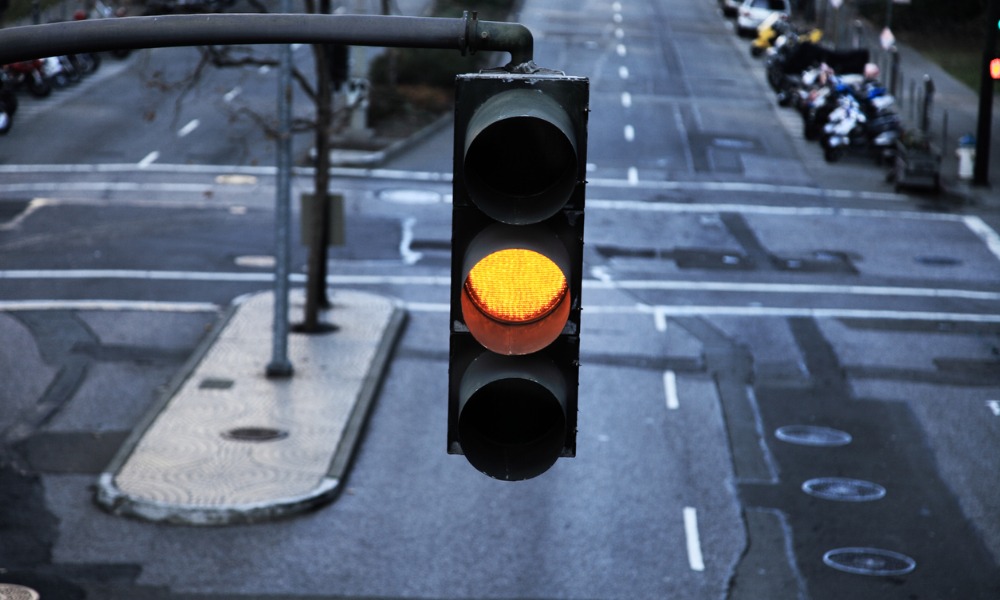
The collision occurred at a busy Vancouver intersection

A driver who failed to appropriately assess and react to traffic lights is liable for the car crash at a busy Vancouver intersection, the BC Supreme Court has recently ruled.
In Colonna v. Kienleitner, 2023 BCSC 1887, Paloma Kienleitner drove east on East 41st Avenue in Vancouver, BC. As she passed through the busy intersection at Clarendon Street, she struck Anna Colonna’s vehicle just as she began her left-hand turn.
The force of the collision caused significant damage to the right rear passenger side of Colonna’s Jeep Cherokee and severe damage to the front of Kienleitner’s Mini Cooper. At the time of the accident, the weather was dark and rainy, and the road was wet.
The parties disputed several details concerning the collision. These include the colour of the traffic lights at various points in time, the speed at which Kienleitner’s vehicle was travelling when she entered the intersection, which driver had the right way, and whether either of them was in a position to avoid the collision.
Colonna and Kienleitner argued that the other is 100 percent liable for the accident. In the alternative, should the court decide that liability is shared, Colonna and Kienleitner argued that the court should apportion liability between 75 to 80 percent in favour of the other.
After carefully reviewing eyewitness testimonies and a dashcam video, the BC Supreme Court ultimately ruled that Kienleitner was 100 percent responsible for the collision. The court noted that the accident involved a collision between a left-turning vehicle and a straight-through vehicle at an intersection controlled by traffic lights. According to case law, in cases involving a crash in an intersection between a left-turning driver and a straight-through driver, the colour of the lights determines which of the drivers has the right-of-way.
Furthermore, the court noted that under the Motor Vehicle Act, when a vehicle is in an intersection, and its driver intends to turn left, the left-turning driver must yield the right-of-way to opposing traffic that is either in the intersection or so close to the intersection as to constitute an immediate hazard. However, having yielded to traffic in the intersection and traffic so close as to constitute an immediate hazard, a left-turning vehicle that has signalled their left turn may complete the turn, and traffic approaching from the opposite direction must yield.
The court also noted from case law that left-turning drivers have a duty to be aware of cross traffic, pedestrians, and whatever else is in an intersection.
The court found that the dashcam video and signal timing evidence supported the conclusion that the light was a stale amber when Kienleitner entered the intersection and turned red just as she crossed the crosswalk. Colonna saw lights in the distance but did not see Kienleitner’s vehicle approaching such that she considered it an immediate hazard.
Kienleitner testified that she could not recall when the light turned amber or where she was when she saw that it was amber. She did not remember taking any actions in reaction to the amber light other than, at some point, determining that she could not stop safely. However, under all the circumstances, the court could not find that she made that determination in response to the amber light instead of seeing Colonna’s vehicle in the intersection immediately before the collision.
The court found that Colonna had a duty to be aware of cross traffic, pedestrians, and whatever else was in the intersection. However, she was entitled to proceed on the assumption that oncoming traffic would act following the law.
The court further found that there was nothing independent of Kienleitner’s belief to establish that she could not have slowed and stopped safely at her stated speed despite the conditions. The court pointed out that nothing obstructed her view of the intersection or the light signal.
Moreover, the court said that the evidence did not support the contention that Kienleitner made a timely or any assessment regarding whether she could safely stop until it was too late. The evidence from the experts’ speed analyses and Kienleiter herself was insufficient to establish that it was, in fact, unsafe for Kienleitner to stop.
While Kienleitner said that her speed was 50 km/hr, the court found that she was going “approximately” 50 km/hr when she approached and crossed the stop line at the intersection. Regardless of whether she travelled at the top end of the range of speed estimates or the lower end, the court found that she could have stopped safely once the light turned amber.
The court also found that Kienleitner’s testimony was significantly lacking in providing helpful or probative evidence. She could not recall anything except for one or two bare details supporting her contention that stopping would have been unsafe. As a result, the court found her testimony was unreliable.
Ultimately, the court found that Kienleitner failed to appropriately assess and react to the amber light even though she had the opportunity and legal obligation to do so. In contrast, the court found that Colonna kept a proper lookout, and it was unreasonable for her to believe that oncoming traffic had stopped or was coming to a stop when she began her left turn.
The court was satisfied that Colonna met the burden of showing that no immediate hazards were present the moment before she began her left turn and that she acted with reasonable care in the circumstances. Accordingly, the court found Kienleitner is 100 percent liable for the accident.